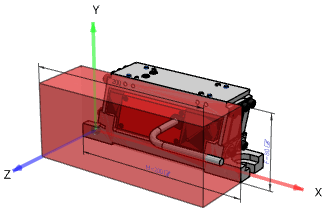As basis for the catalog creation CADENAS requires the below specified original data from the contractor. Necessarily, the data has always to be supplied as a complete package for every part / assembly and/or chapter-wise related to the total size of order.
On request (e.g. for larger data volumes), CADENAS can also provide the client with a special area on an FTP server for data transfer.
We can only guarantee equivalent quality if the data supplied meets the requirements listed below. In the event of major deviations, any delivery dates agreed in advance will lose their validity and additional costs may be incurred.
Both parties are obligated to not hand out any data or models to competitors or to give them patent rights in any form. The contractor assures to CADENAS that the data is free of rights of 3rd party persons / companies.
CADENAS and the contractor will create a project table in which the size of order and the priority of development for all included parts is defined.
The contractor has to deliver a prepared folder structure of the catalog that has to be created. It must be clear which part / assembly has to be in which folder / chapter of the final catalog. The Structure can be provided in two ways:
We recommend keeping the folder names in English here, as these cannot be translated into other languages compared to the structure displayed later in PARTdataManager.
A corresponding preview image should be included for each folder/component. The catalog can thus be optimally adapted to the client's "corporate identity". If preview images are not available, they can be generated from the 3D models using a batch routine. See Section 5.8.2.1.15.4, “ Generate image data/preview images in batch run ”.
Technical prerequisites Preview Pictures:
![[Note]](https://webapi.partcommunity.com/service/help/latest/pages/en/ecatalogsolutions/doc/images/note.png) | Note |
|---|---|
Please save the preview images - if available - directly in the folder structure with the file name "catalog.png"! | |
![[Note]](https://webapi.partcommunity.com/service/help/latest/pages/en/ecatalogsolutions/doc/images/note.png) | Note |
|---|---|
Preview images can also be generated per line ( PARTproject -> Project selection context menu -> Output -> Generate preview images per [Create previews per line] line). These are then combined into a single file. In contrast to the usual standard size of 400x400 pixels, the size per individual image here is 150x150 pixels. In this example, the total size is 450x450 pixels, which means that each individual image is 150x150 pixels.
You can find more information on this under Section 5.8.2.1.15.5, “ Create previews per line ”. | |
For each part / assembly CADENAS has to implement a dimension drawing. These dimension drawings explain the user what variable in the table controls which dimension in the 3D model.
Technical requirement Dimension Drawings:
Vector graphics: AutoCAD-DWG or -DXF
At least continuous lines, centre/pitch/circle lines, hidden lines, dimensioning and threads on separate basis-layers
Pixel graphics: Pixel graphics such as BMP or TIF should not be used. Due to the lack of layer division and poor scalability, this would be very disadvantageous in many end media.
In PARTproject autoCAD DWG or DXF files can be imported and converted into the program's own .pra format (either created by CADENAS or provided by the customer). See Section 5.11.2, “ Create and import/convert dimensioning views externally ”.
Alternatively, you can use PARTdesigner to create dimension views from the standard 2D derivations. See Section 5.11.1, “ Create dimensioning views with PARTdesigner ”.
Dimension tables must be supplied in CSV/XLS format. The contents can usually be imported into the system without loss. The client also declares variable names, variable designations, variable units and the contents of selection fields at this point if necessary. The table covers all geometrically required variants and, if necessary, also contains all auxiliary dimensions and technical details required for the design. See Section 7.12.17, “ Import CSV file ”.
For the creation of the 3D geometries CADENAS requires detailed CAD data of all parts / assemblies + variants that have to be realised. CADENAS can work with file formats like STP, SAT, IGS, DWG, DXF, etc. as well as with most formats of established CAD systems.
The contractor delivers all required print catalogs at least twice for every language. A PDF version of the catalog can also be provided additionally or alternatively. Please send these documents directly to hands of your CADENAS contact person.
The contractor defines together with CADENAS the general Level of Detail. It will be defined in and release with the pilot parts later.
There is also the option of a changeable level of detail (see "LOD function" below). A changeable level of detail is particularly relevant when target systems from very different markets (e.g. mechanical engineering and building construction) need to be supported equally.
If there are any special requirements to the placement / orientation of the parts in the 3D-coordinate system, it needs to be declared and defined between CADENAS and the contractor before the modeling begins. Otherwise the models will be placed in the CADENAS typical way.
![[Note]](https://webapi.partcommunity.com/service/help/latest/pages/en/ecatalogsolutions/doc/images/note.png) | Note |
|---|---|
For all BIM (building information modeling) projects the orientation “z-axis on top / x-axis in front” is mandatory. See Section 5.8.2.1.2, “ New project ” -> Template for 3D project Architecture with LOG (Z-axis above) / Template for 3D project Mechanical engineering with LOG (Y-axis above). | |
The CADENAS part families are able to be built up as single parts or assemblies. If it is required that the parts are moveable in a specific way and therefore have to wear additional kinematical information, then it possibly needs to be specified by the contractor. For the usual linear and rotative movement also min. + max. limits can be set up. This especially is relevant, when the parts later should be used in simulation systems (see next point).
If a simulation system such as the Mechatronics Concept Designer (MCD) is to be operated with the CADENAS parts, further technical information such as speed, max. acceleration, max. deceleration, etc. is required in addition to the kinematic movement information (see previous point). Motion diagrams can also be stored and must usually be provided. Please ask your CADENAS contact person for further information. (See also Section 2.5.8.2.8, “ NX: Testing PARTsolutions parts in the Mechatronics Concept Designer” in ENTERPRISE 3Dfindit (Professional) - User).
The parts and assemblies created in CADENAS can be created in multiple colors to match the real products and the client's CI. There are some restrictions when adding color to the components and exporting the parts to the CAD system. Please obtain information from your CADENAS contact person before starting the project. (See also Section 5.9.2.8, “Menu item: Render properties ”.)
Materials can be stored for the parts in the Electronic Product Catalog, on the one hand to provide the user with additional information and on the other hand to be able to render the products photorealistically later (see also Section 5.9.2.3, “Menu item: Variables ” -> Mapping to CNS classification -> Material)
Various selection and table functions are available for convenient configuration of the CADENAS products. An attempt is made to respond to all the customer's wishes and also to reuse successful systems from reference projects. See Section 5.9.2.3.2, “ Creating variable groups (at catalog level) ”.
For an optical improvement it is also possible, to use (schematic) icons for the selection in the product table. The contractor should supply these pictures if possible or order us to create them.
Technical requirements Pictograms:
See Section 7.8.13.3, “Type "Value range variable with graphics " ”" Section 7.8.13.3, “Type "Value range variable with graphics " ”.
Each part/assembly in the catalog must be assigned a unique standard number [Standard number] (NN), standard title [Standard title] (NT), standard designation [Standard name] (NB), short designation [Short name] (KB) and a fixed parts list designation [BOM name] (LINA). The client provides all the necessary information and creates the required designation keys together with CADENAS.
The standard number [Standard number] (NN), standard title [Standard title] (NT), standard designation [Standard name] (NB) and parts list designation [BOM name] (LINA) are entered later in the PARTdesigner dialog box (see Section 7.17.9.2, “ Table ”), the short designation [Short name] (KB) is entered in PARTproject under Edit project -> General tab -> Short designation (max. 16 characters) [Short name (max. 16 characters)] (see Section 5.9.2.1, “Menu item: General ”).
NT: Norm title [Standard title]
2. Part of the designation in the PARTdataManager
e.g. Flanges, clogged for soldering or welding nominal pressure 6, form A
NB: Standard designation [Standard name]
Name in CAD system (feature tree)
Filename in the pool (max. 256 characters)
z.B. NB='Flansch DIN 2573 $NENN.' (whereby NENN is an attribute algorithm and again contains the variables NW and D1.
NW and D1 represent the nominal size and the pipe's connection dimensions -> uniqueness
LINA: Parts list designation [BOM name]
Default identification in ERP Systems
Often similar to the NB, but without variables of type functional characteristic (see Section 7.8.14, “ Identification type ”)
Short name of NB (max. 16 characters)
used by CAD systems that are not compatible to strings of more than 16 characters
Please also note our NB/LINA guideline. See Section 7.17.9.3, “ Guideline for NB, SHORTNB, LINA definition and type identification ”.
If your catalog contains products that are standardized according to a national or international standard (e.g. DIN, EN, ISO, etc.), it is essential to ensure that the standard number is always specified in the NN or NT - this way the parts can also be found later using the "Standards " classification system.
Depending on the agreed end media, logos are required in the following versions:
| PARTsolutions: | 1x Supplier Logo, PNG, 400x400 Pixels, 8 Bit, max. 20KB |
| Catalog DVD: |
1x manufacturer logo, PNG, 400x400 pixels, 8 bit, max. 20KB |
| PARTcommunity: | See document „Order PARTcommunity“.[a] |
[a] On this, please contact CADENAS. | |
If certain additional documents are required for catalog creation (e.g. sketches, formulas, data sheets, diagrams, etc.), these must be provided by the client in advance.
CADENAS can also implement additional documents (e.g. catalog pages in PDF or HTML format) in the form of document projects in the PARTsolutions catalog at the client's request. The preparation and provision of the data is also the responsibility of the client. See Section 5.8.2.1.16.6, “ Create document project ” document projects, Section 5.9.2.3.5, “ Variables containing external references ”.
CADENAS aims to make the catalogs more and more interactive – “1 picture tells more than 1000 words and 1 Video tells more than 1000 Pictures”. Your CADENAS contact person helps you to make the catalog grow to a multimedia “eye catcher” (compare last point).
It is possible to equip the parts and assemblies in a catalog with so-called "automatic dimensions", which can then be displayed both in the 2D derivation and in the 3D viewer. Individual dimensions can also be configured so that the end user can click on them and select alternative component variants. See Section 7.16, “ Docking window "Dimensions " ” derivation.
If there are components (in an assembly) that are very long in relation to the other installed components (e.g. linear units, cylinders, ball screws, etc.), it is advisable to implement a "Shortened view" for optimum 2D derivation (also possible for automatic dimensioning) - this means that very long components are displayed and dimensioned in a shortened form. This is often also relevant if an individual PDF data sheet is required as the final medium. See Section 5.10.1, “ 2D derivation: Alternative 2D size (shortened) ”.
If there are defined areal spaces in which no other parts should be placed (in order to avoid collision) or if there are working spaces (e.g. action radiuses of robots, etc.) they can be hosted in the catalog as an additional value.
Information on many connection types can be stored in the CADENAS parts and also transported to many target systems. All information regarding connection type, connection standard, nominal diameter, media type, etc. must be provided in advance by the manufacturer. See Section 5.12.3, “Classifications ”.
Optionally, the client can provide catalog data from a database in the form of the standardized exchange format BMEcat. The BMEcat format is based on XML technology and allows the exchange of catalog data and product classification systems. Among other things, the complete catalog structure, designations, parts list data, preview images and tables of all products can be transferred. See Section 5.8.2.1.15.12, “ Write BME catalog ”.
In order to make the CADENAS end media also for purchasing departments more and more interesting (catchword “Purchineering”) it is very meaningful to explicitly mark parts which equal a national or international standard (e.g. DIN, EN, ISO, etc.) within the CADENAS catalog, because these parts are often preferred and bought primary from many companies, as they can be replaced easily in existing constructions. So - if possible - please provide us this information.
Marking can be achieved by following means:
Automatic entry in the standards classification. See Section 5.8.2.1.15.1, “ CIP catalog ” -> Automatic classification of standardized parts.
Manual via entry under Edit project -> General tab -> General menu item -> Similar to standard (optional) [Similar to standard parts (optional)]. See Section 5.9.2.1, “Menu item: General ” menu item.
Manual entry in the standards classification. See Standards Section 5.12.3.4, “Classification (Standards) ”.
Corporate purchasing departments also benefit greatly from knowing where the nearest procurement location is to which they can send a request for quotation. The location addresses should therefore definitely be provided by the client so that they can also be embedded in the catalog and in the CADENASend media. In addition to the "manufacturer's own" locations, dealer locations are also welcome. See Section 5.12.3.2, “Classification (By Categories) - (By Countries) - (By Functionality)”.
In addition to the procurement locations (see previous point), a supplier country classification is also requested --> Which location delivers to which country? This set of rules can be implemented in the CADENAS catalog and creates added value for purchasing departments. See Section 5.12.3.3, “Classification (country of delivery ) ”.
Classification according to eCl@ss is becoming increasingly important and CADENASis therefore trying to equip as many manufacturer catalogs as possible with the corresponding classes and features. This offers users decisive advantages. The client is responsible for providing the classification data - but CADENAS will be happy to support you in this. See Section 5.12.4, “ Add projects to classification (context menu) ”.
In the CADENAS end media, users can find product catalogs not only by manufacturer name but also by product category. It is therefore important that the catalog category is defined as accurately as possible. An overview of the currently available categories can be found on the Internet at cadenas.partcommunity.com > All categories. See also Section 3.2.15, “ Classification by Category / Alphabet / Country ”.
CADENAS has a large number of other classification systems into which the manufacturer data can be incorporated. If required, CADENAS can also create a new/own classification system together with the client. Talk to your CADENAS contact person about this. See Section 5.12.12, “Create or edit your own class system ”.
Information regarding environmental protection certificates or system standards can be managed in the catalog data. Please provide us with such information at the start of the project. See Section 5.12.3.1.4, “Class "CNSERPBASE" -> Characteristic "CNSCERTIFICATEROHS " ”" Section 5.12.3.1.4, “Class "CNSERPBASE" -> Characteristic "CNSCERTIFICATEROHS " ”.
If the catalog is modeled in several, changeable levels of detail (this usually requires a separate agreement / order), the information and ideas regarding the reduction scheme must be defined by the customer in advance with CADENAS. Especially in the areas of BIM (Building Information Modeling) and Plant (plant construction), a changeable LOD is becoming increasingly important or is even a mandatory requirement in order to be able to optimally support some target systems. See also Section 5.8.2.1.2, “ New project ”, Section 5.8.2.1.16.14, “ Add LOD Variables ”, Section 5.9.4.3.5, “Example: Specifics for project creation especially in Architecture / BIM catalogs ”.
Weight information is particularly important for users in the ERP sector, as storage weights and/or transportation costs have to be calculated, for example. The total weight of an assembly often plays a major role in design. Help the users of your catalog by providing weight information for inclusion in the catalog. See also Section 5.9.2.3, “Menu item: Variables ” -> (Variable with mass, material, density).
In many industries / target systems, the center of gravity of components is an important attribute. At the client's request, this can be managed in the catalog data and, if necessary, transferred to the target system for further functionality. As the calculation using model geometry and materials alone would be too imprecise, the XYZ coordinates of the center of gravity are required in advance for each part in this case. See Section 5.12.3.1, “Classification (CNS) ”.
If a construction manufactured by the end user is later to be exported abroad, customs tariff numbers must be specified for all manufacturer parts used. This can be a very tedious and time-consuming task. Since it is possible to store the customs tariff numbers in the catalog and automatically transfer them to a connected ERP system, the end customer's work is made much easier. See Section 5.12.3.1, “Classification (CNS) ”.
Insofar as it is possible to provide information on (general) standard delivery times, these can also be included in the catalog and greatly assist the end customer. See Section 5.12.3.1, “Classification (CNS) ”.
If the manufacturer has a set of rules regarding which articles / article variants are to be discontinued and/or replaced by other articles at a certain point in time, it is advisable to also store this information in the CADENAS catalog. However, it is not advisable to simply delete items from the catalog, e.g. during ongoing product maintenance / maintenance of the catalog, as many CADENAS end customers have references in target systems. See Section 5.9.2.12, “Menu item: Expiry date (End of Life) ”.
If the manufacturer's products have a time interval in which technical maintenance must be carried out, this valuable information should be included in the catalog. See Section 5.12.3.1, “Classification (CNS) ”.
If accessories or spare parts exist for the catalog products, these should be explicitly stated in the CADENAS catalog. A corresponding set of rules must be supplied by the client. See Section 5.9.10, “Tabbed page: Accessories ”.
It is possible to create "small" calculation aids / calculation wizards in the catalog parallel to the product projects, which support the user in the selection process or provide a selection alternative. If you have any ideas, we will be happy to advise you. See Section 5.17.2, “ Create search wizard / calculation wizard ” calculation assistant.
In order to guarantee the catalog users an optimal part search, CADENAS requires information from the customer as to which values are to be searched for in which variables. It is strongly recommended and "standard" to declare e.g. the article number for this - but there may be other "search variables" that are relevant for this and should be defined. See Section 5.9.22.1, “dir.prj ”.
If the catalog is to be published in several languages, the client is generally responsible for translating the terms appearing in the catalog. For this purpose, the client receives the necessary translation tables in XLS format from CADENASonce the modeling phase has been completed.
Alternatively, CADENAS can be commissioned for the translation, but only by special agreement and with additional costs. See also Section 5.8.2.1.14, “ Translation ”.
Any source data provided, which may contain trade secrets of the client, shall always be regarded as strictly confidential by CADENAS. This includes, for example, information about manufacturing processes, materials, patent, copyright and trademark rights, supplier lists, etc.
This is also done without explicit reference, insofar as it is not information generally made available to the public by the client.
Please refer to the document "Confidentiality agreement "![11]
If you have any questions, please contact CADENAS at any time!
See Section 3.2.28, “Creative Commons license for export formats”


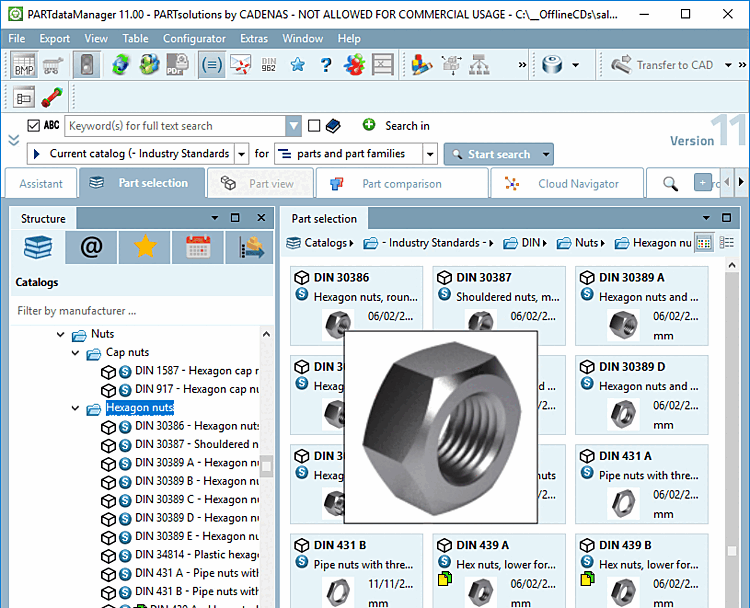
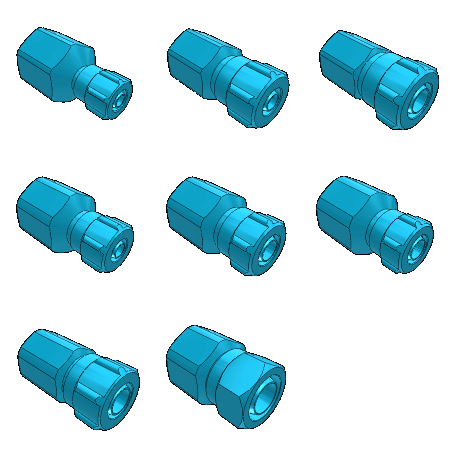
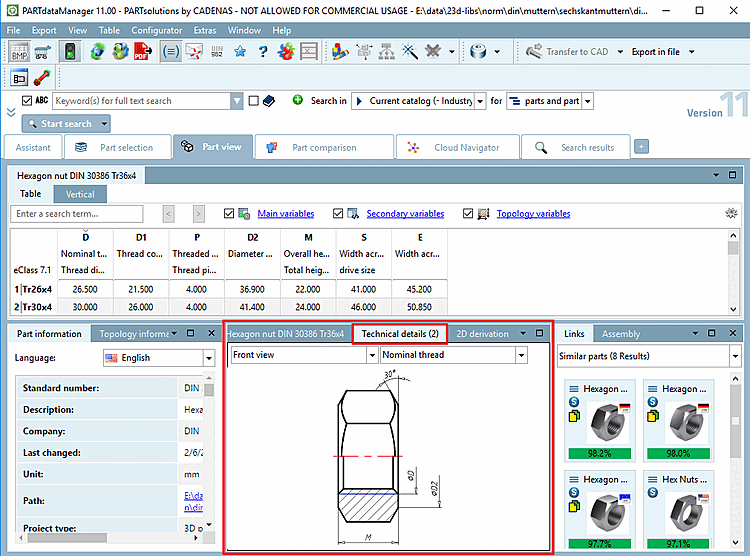

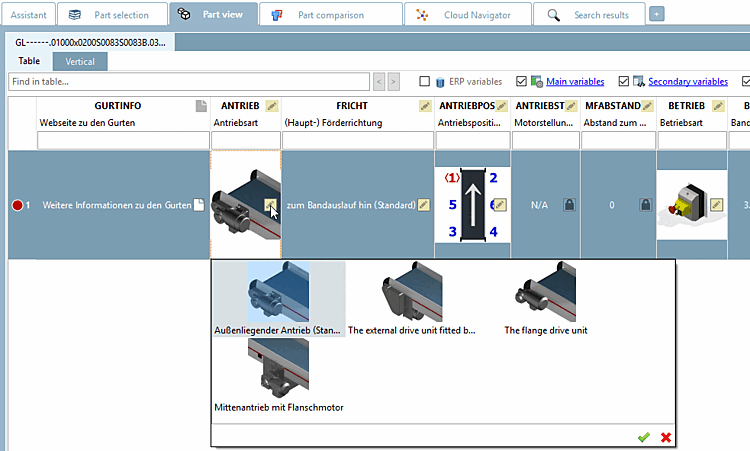
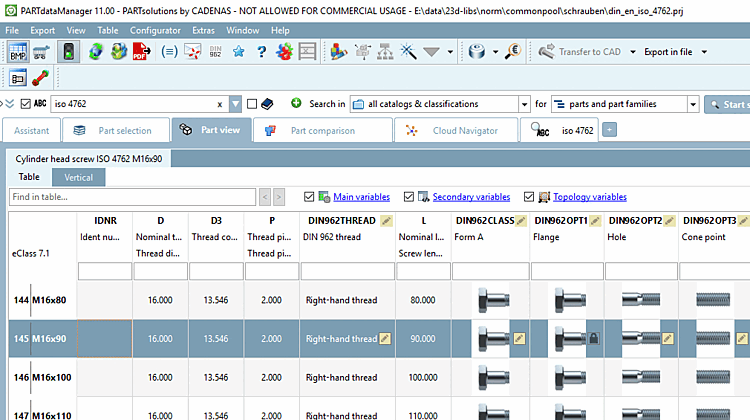
![Standard number and standard title [Standard title] in PARTproject](https://webapi.partcommunity.com/service/help/latest/pages/en/ecatalogsolutions/doc/resources/img/img_995fa49e80624292bb1b22480783c9ca.png)
![Standard number and standard title [Standard title] in PARTdataManager](https://webapi.partcommunity.com/service/help/latest/pages/en/ecatalogsolutions/doc/resources/img/img_f37e8f1c551447548d53d9e15117bd5b.png)
